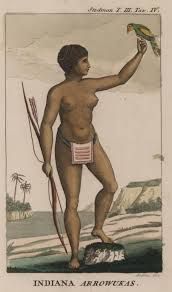
521 years ago, Christopher Columbus boarded his Spanish ship and sailed west. He had no idea where he was headed, and he almost gave up. In his Diario, on Wednesday, 10 October, he wrote:
“Here the men could no longer stand it; they complained of the long voyage.”
A day later, they saw floating sticks and canes and planks; then, 2 hours after midnight on the 12th, they discovered a New World—and its inhabitants. In his diary, Columbus added these notes:
“All of them go around as naked as their mothers bore them,” and,
“They are all very well formed, with handsome bodies and good faces,” and,
“They should be good and intelligent servants.”
When the Admiral of the Ocean Sea sailed out of Andalusia, on the 3rd of August, in his carrack and 2 caravels manned with laborers, peasants and convicts, they were all looking for 3 things. They wanted gold and other forms of movable wealth. They wanted real estate. And they were looking for members of the opposite sex.
They called their ships La Niña, and La Pinta, and La Santa María, roughly translatable as “The Girl,” and “The Painted Lady,” and “The Saint Mary”—after the Perpetual Virgin.
They called the Caribbean Islands they stopped by Santa María (for the Virgin), and Santa Ursula (for another virgin), and Las Once Mil Vírgenes (for her 11,000 virgin friends)—said Columbus’ son, Ferdinand.
And when they found native American women—good and intelligent, well formed and naked as their mothers bore them—they took them. They took them with their swords, crossbows, muzzle-loaded guns and small cannon; they took them away from their mothers and fathers and husbands.
With their own wooden clubs and poison tipped arrows, native American men—the Taínos and others who encountered Columbus—had taken women away from each other for generations, of course. Some had collected several. But most made do with a few.
When Columbus wrote home to his illustrious sovereigns, Ferdinand and Isabella of Spain, he had this to say about the native Americans he knew: “It seems to me that all men are content with one woman.” He admitted that, in the islands, some caciques, or chiefs, hoarded as many as 20 girls. And other Spaniards would discover that, on hard-to-escape parts of the mainland—in the Valley of Mexico, and in valleys in the Andes—emperors hoarded more. But on the wide open spaces across most of the Americas, sex and politics were relatively egalitarian.
Because it was relatively easy to run away.
We can hope that it stays that way.
References
Columbus, Christopher. Diario of the First Voyage to America 1492-1493, translated by O. Dunn and J. E. Kelley. Norman: University of Oklahoma Press, 1989.
Columbus, Christopher. Letter, Describing the Results of His First Voyage, translated by C. Jane and L. A. Vigneras. London: Orion Press, 1960.
Columbus, Ferdinand. Life of the Admiral Christopher Columbus, translated by Benjamin Keen. New Brunswick: Rutgers University Press, 1959.


